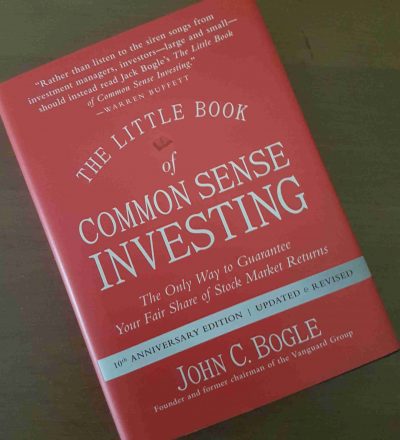The Little Book of Common Sense Investing- Book Review

Premise of the book
The book primarily focuses on the stock market and goes into great details to demonstrate how index funds perform better than the vast majority of investors, professional or not.
About the author
John Bogle has been described as a missionary. He has changed the investment world forever through his invention: the index fund.
Bogle also successfully challenged the foundations of Wall Street and professional money managers by founding The Vanguard Group, one of the few non-profit asset management companies in the world. As an investment manager he forgone easy profits by trying to reduce management fees to the bare minimum, effectively challenging Wall Street’s business model of extracting exorbitant fees from unwary clients.
Index funds now make up the pillar of every serious investor’s portfolio, and that’s all thanks to John Bogle’s vision.
Structure of the book
The book is divided in three parts:
- Understanding how investors make money – The author sums-up how dividends, earnings growth, and increase in business size (capitalization) all contribute to an investor’s total return;
- Understanding the curse of compounded fees – Bogle lays siege to professional investment managers with a tirade of examples to demonstrate why active management continuously under-performs passive investing and index funds;
- Understanding asset management – Bogle ends his book with timeless advice on asset allocation describing the benefit of diversification, dollar-cost averaging, and periodical rebalancing.
Key takeaways of The Little Book of Common Sense Investing
The book is packed with easy-to-understand content. The concepts brought forward are packaged in a simple and reader-friendly way which makes it a joy to read through. The book covers all the basis for successful investing and encompasses advice for all investing profiles. Here are my top 10 takeaways from The Little Book of Common Sense Investing by John Bogle:
The fundamentals
1. Shareholder gains must match business gains. The only way you can make money through owning a stock is through its earnings, whether that is paid out in the forms of dividends, cash reinvested to grow the business, or in the form of earnings growth. Bogle provides historical evidence to demonstrate that while the stock market may go up or down over certain periods, in the long term it always follows business earnings;
2. Fees matter. The real stock market gains are made from business gains. As such, there is nothing to gain from brokerage fees or mutual funds’ management fees. Fees eat away your investment returns. With fees, instead of enjoying compounding interest, you’ll suffer the curse of compounding costs;
3. Stay invested. The average mutual fund investor underperforms the returns of the average mutual fund, how is that possible? Bogle explains that people have a perversion for trading in and out of them. In fact, people tend to pour cash into mutual funds AFTER the fund had a great year (because how else would you know it’s a good fund?) and take their cash out AFTER a bad year. This behavior leads investors to buy high and sell low, which is the opposite of what you should do;
On the stock market
4. Don’t try to time the market. Forecasting short term swings in investor emotions isn’t possible. However forecasting the long term economics of investing has carried remarkably high odds of success;
5. Plan for lower returns. The stock market does not owe you anything. Just because it has averaged returns around 9-10% annually does not mean that it will continue. In fact Bogle argues that as the speculative returns (measured as increase in the PE ratio) has increased considerably over the last two decades, future returns must be lower. John Bogle demonstrates that between 1973 to 2016, 25% of the S&P 500’s returns came from increases in PE ratio (i.e. speculative returns) and not from earnings growth or dividends. Bogle concludes that it is unwise to expect further increase in speculative returns as stock prices will revert back to their fundamentals sooner or later;
6. Don’t look for the needle in the haystack, buy the haystack instead. It is tempting to search for the next Apple or Microsoft in an effort to get rich quick, but such efforts rarely bear fruits. Opt for an index fund instead to ensure that you will own shares in the next big thing!
7. The stock market is a giant distraction to the business of investing. We often focus on short term prices instead of long term returns. Checking on your portfolio everyday is futile, focus on long term gains;
Asset Allocation
8. Consider historical bias. Each great investor represents the era of their time. Ben Graham, the father of value investor, never experienced a single year where dividends beat bonds in his career. In contrast Bogle never experienced a single year where bonds beat dividends. Graham thus proposed a 50-50 allocation of stocks to bonds while Bogle proposed a 60-40 allocation. With today’s low interest rate environment, the next best seller book is probably going to propose a 70-30 allocation;
9. Your bond allocation should roughly equate your age. Bogle is famous for this advice on asset allocation but even he admits it should be taken as an indication, not as a hard rule. In fact, Bogle advises young investors to hold a 80/20 stocks to bonds allocation for the youth, 70/30 for older investors, 60/40 for young retirees, and 50/50 for older retirees;
10. Remember your risk tolerance. The author concludes by insisting that your stock allocation should be as large as your risk tolerance allows. His highest recommendation would be 80/20 and lowest is 25/75. Yes you read that right, the lowest possible stock allocation is 25%. So if you’re not owning stocks today, you’re probably doing it wrong;
The verdict
Let’s be honest, any book that has both the names of John Bogle and Warren Buffett on its cover is going to be a great book.
The author is the inventor of the index fund, so it is no surprise that he tries to laud his invention as the next big thing. What is surprising however, is the sheer quantity and quality of arguments in the book that demonstrates why index funds outperformed mutual funds in the past and why they will continue to do so in the future.
If you weren’t convinced about index funds before, this book will surely change your mind.

Great article.
Thanks for the support! I hope the article was useful!
Very neat blog post. Really looking forward to read more. Want more. Herbert Tidrington
Hi, I do believe this is an excellent website.
I stumbledupon it 😉 I am going to come back once again since I book-marked it.
Money and freedom is the greatest way to change, may you be rich and continue to help other people.